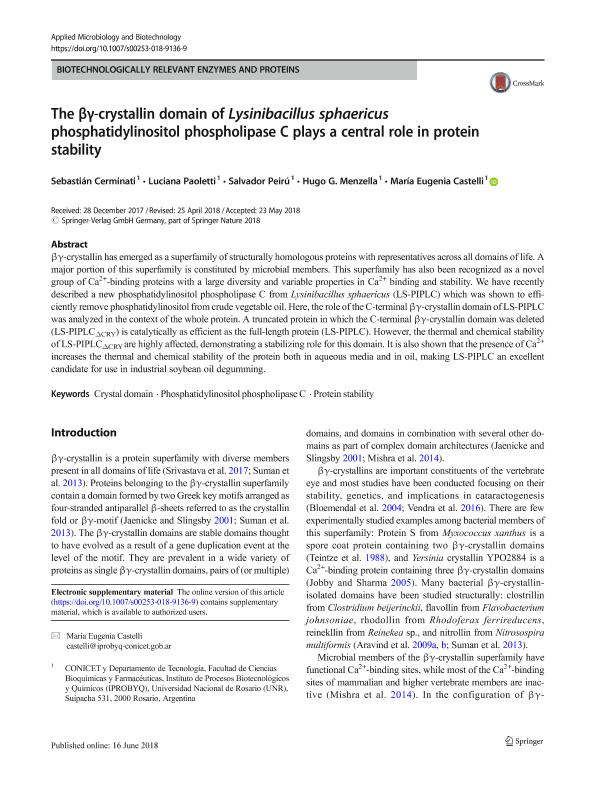Artículo
The βγ-crystallin domain of Lysinibacillus sphaericus phosphatidylinositol phospholipase C plays a central role in protein stability
Cerminati, Sebastián ; Paoletti, Luciana Elisa
; Paoletti, Luciana Elisa ; Peirú, Salvador
; Peirú, Salvador ; Menzella, Hugo Gabriel
; Menzella, Hugo Gabriel ; Castelli, Maria Eugenia
; Castelli, Maria Eugenia
 ; Paoletti, Luciana Elisa
; Paoletti, Luciana Elisa ; Peirú, Salvador
; Peirú, Salvador ; Menzella, Hugo Gabriel
; Menzella, Hugo Gabriel ; Castelli, Maria Eugenia
; Castelli, Maria Eugenia
Fecha de publicación:
08/2018
Editorial:
Springer
Revista:
Applied Microbiology and Biotechnology
ISSN:
0175-7598
e-ISSN:
1432-0614
Idioma:
Inglés
Tipo de recurso:
Artículo publicado
Clasificación temática:
Resumen
βγ-crystallin has emerged as a superfamily of structurally homologous proteins with representatives across all domains of life. A major portion of this superfamily is constituted by microbial members. This superfamily has also been recognized as a novel group of Ca 2+ -binding proteins with a large diversity and variable properties in Ca 2+ binding and stability. We have recently described a new phosphatidylinositol phospholipase C from Lysinibacillus sphaericus (LS-PIPLC) which was shown to efficiently remove phosphatidylinositol from crude vegetable oil. Here, the role of the C-terminal βγ-crystallin domain of LS-PIPLC was analyzed in the context of the whole protein. A truncated protein in which the C-terminal βγ-crystallin domain was deleted (LS-PIPLC ΔCRY ) is catalytically as efficient as the full-length protein (LS-PIPLC). However, the thermal and chemical stability of LS-PIPLC ΔCRY are highly affected, demonstrating a stabilizing role for this domain. It is also shown that the presence of Ca 2+ increases the thermal and chemical stability of the protein both in aqueous media and in oil, making LS-PIPLC an excellent candidate for use in industrial soybean oil degumming.
Palabras clave:
CRYSTAL DOMAIN
,
PHOSPHATIDYLINOSITOL PHOSPHOLIPASE C
,
PROTEIN STABILITY
Archivos asociados
Licencia
Identificadores
Colecciones
Articulos(IPROBYQ)
Articulos de INST. DE PROCESOS BIOTECNOLOGICOS Y QUIMICOS ROSARIO
Articulos de INST. DE PROCESOS BIOTECNOLOGICOS Y QUIMICOS ROSARIO
Citación
Cerminati, Sebastián; Paoletti, Luciana Elisa; Peirú, Salvador; Menzella, Hugo Gabriel; Castelli, Maria Eugenia; The βγ-crystallin domain of Lysinibacillus sphaericus phosphatidylinositol phospholipase C plays a central role in protein stability; Springer; Applied Microbiology and Biotechnology; 102; 16; 8-2018; 6997–7005
Compartir
Altmétricas



